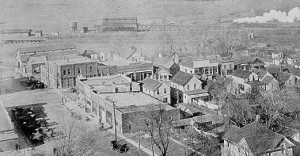
MANNING

Preliminary railroad surveys showed that one of the tracks would extend into the Samuel Bingham farm in Crawford County. The Western Town Lot Company, an agency of the Chicago NorthWestern Railroad, immediately purchased 80 acres from Bingham to be sold as town lots.
The survey was rejected, and through some maneuvering of the various railraods, it appeared that the lines would be crossing 31/2 miles northeast of the Bingham farm. The site was at a farm owned by A.J. Jeffries since 1874. George Gray, a farmer in northern Audubon County who eventually purchased much of the land along the proposed railroad sites, bought the southwest 1/4 of section 17, Warren Township, from Jeffries on June 21, 1881. Gray paid $3,800 for the land; the same day, Gray sold the northeast corner of the farm to the Western Town Lot Company for $1, 500.
Jeffries' farm house, stable, and granaries were the only buildings on the future town site. The farm house was immediately removed, and the Park Hotel later built in its place. Rix Brothers Standard Station is on the site today.
As soon as it was evident that this was to be a town, a name was sought. Some felt it should be called "Jeffry Junction". Others wanted to call it "Warrick", the name of a railroad water supply station a mile to the southeast. The name "Manning" came into being to honor the lawyer, O.H. Manning, who handle land transaction for the Western Town Lot Company.
Lots began selling July 28, 1881, and 53 had been sold by August 25. A combination grocery and hardware store, saloon, and doctor's office was the first building, located where the Manning Plaza now stands, and John Ferguson built the first house at 315 Center on the lot today occupied by the Ed Ramsey family.
Until September 5, practically all building materials had to be hauled in from Carroll and Arcadia by team and wagon. The opening of the NorthWestern Railroad track made it much easier to obtain materials, and construction boomed. A late September tornado destroyed several of the buildings then under construction, adding only a temporary delay to the pace.
In October, the new town recorded its first birth and first death. Mr. and Mrs. P.A. Emery rejoiced in the birth of a daughter, born in their living quarters above a barn. Friends and relatives mourned the untimely loss of Mrs. Elizabeth Merry, age 18.
The Manning Monitor began publication November 17, 1881, and it reported that there were then 414 people in town. There were 85 "good substantial buildings", the paper noted, 45 of which were businesses.
Only six weeks later, there were 112 buildings either up or in the process of construction. The population had grown to 568, with 343 males and 225 females. This did not include the 80 men and five women in town for the winter laying railroad track.
A minor fire was reported December 28, 1881, when shavings caught fire from a workman's stove in the Callison Building, which was then being built. Only a few tools were scorched.
The first major blaze occurred in April, 1882, when 13 buildings were lost. There was no fire apparatus nor water at hand, and the entire population turned to saving as much movable property as possible. The losses amounted to $32,000.
Undaunted, the workers continued to build. By the time the Monitor printed its first anniversary edition, there were twice as many people and dozens of shops, offices, and warehouses.
"A year ago Manning was but an unsolved
Continued from page 13
problem," the paper stated. "Today, she is an established town of 900 people (which number is rapidly increasing) with busy merchants and tradesmen, and streets crowded with loaded teams from the rich country that surrounds her on every side. One year ago she had one branch road, with one train a day, bringing in the passengers and freight together.
"Today she has the branch turned into a thoroughfare, the Iowa Southwestern, and branching again within the limits of the town; besides the main line of the great Chicago, Milwaukee & St. Paul Railway, which also passes through the incorporation, and while we write, is constructing a fine depot and freight house immediately at the end of Main Street. Both these roads give us close and direct communication with Chicago; Des Moines and Council Bluffs, and with Carroll, Audubon, Harlan and the fine new towns on the line of the Milwaukee."